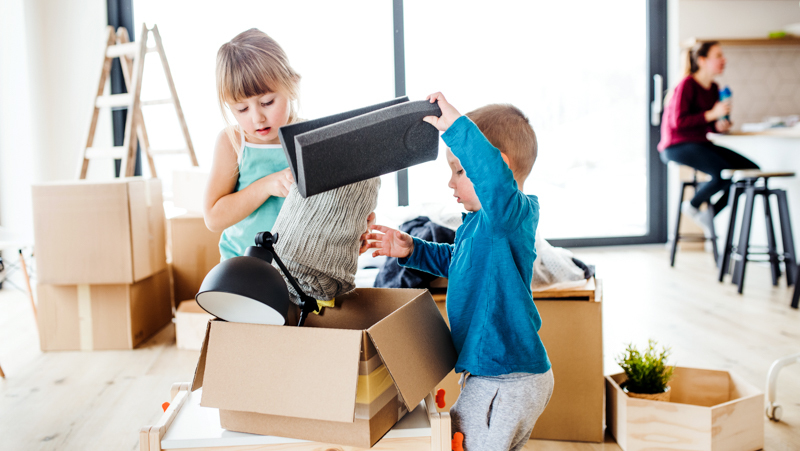
Written by Val Jordan on August 26, 2021
Moving can be about new adventures, making friends, and exciting life changes, but it’s rarely unaccompanied by stress — especially for kids. Nearly one-third of parents worry about causing undue stress for their children during a move, and with good reason. Any type of relocation can not only disrupt kids’ friendships and daily routines, but can be even more challenging for those predisposed to introversion or anxiety.
Whether your child is a toddler, a teenager or somewhere in between, there are steps you can take to decrease moving-related stress, starting with having conversations early, listening to their concerns, and making them a part of the moving process.
Tips for telling your child you are moving away
The amount of detail and the language used depend on the age of your child, but it is generally helpful to clarify when the move will take place, the reason for moving, who and what will move and all the exciting details about their soon to be home.
When we’re moving
Clearly state when the move is happening. If it’s soon, explain that in terms your child will understand; it’s 10 sleeps away, at the end of your school year or remind them of something you did that took a similar amount of time or something that happened a similar number of weeks ago. Help your child understand when this change will occur.
Why we’re moving
Find and share the most positive reason for the move. Maybe you’re moving for a job relocation. Share the name of your new company, your new role and the positive impact that will have on your family. Maybe you’ll be closer to relatives, or excited to increase the size of your house, or gain access to a desirable school.
Who and what is moving with us
Young kids especially need candid explanations about the family members participating in the move. Is this the entire family, everyone in the household, just one parent, the neighbors? Next, if it applies to your situation, explain that most things besides the walls, floors, appliances and yard are coming. All their toys, their bed, their favorite stuffed animal and their art supplies get to move too.
Where we’re moving
Have a photograph of the house ready to share, or a virtual tour of the home if available. Tell your child the address, the name of the city and neighborhood. Pull out a map of the area and mark all the interesting, nearby attractions; a park, playfield, beach, toystore, bookstore, zoo, theater or the proximity to friends or family.
Show your child where their new daycare or school will be, and its name or exciting features. Maybe share a picture of their new teacher or a photograph of some of the students from the website. Allow them to visualize themselves in their new community.
Answer questions
Allow them time to ask questions. Maybe they won’t have any immediately, but when they do, it can be a good opportunity to share your own experiences to create more context and connection. It’s possible they’ll be angry. Try to remain patient while listening to their concerns and validating them. It could take a year before they’re at ease with the move.
Tips for moving with kids
Wondering how to pack and move with kids? A great way to pull off a move with kids is to involve them in the process of packing, moving and settling into the new community. After you’ve told them about the upcoming move, try to get them excited and participative.
1. Delegate the packing.
Each family member can take on a few packing goals each day, or compete as a family to pack full rooms. Turn up the music, dance-pack, or at least keep the energy upbeat. If your kids are too young to effectively pack, give them a temporary box to feel useful.
2. Expand packing supplies.
Stock up on boxes, tape and markers, but also grab stickers, paint pens and a label machine. Let your kids go crazy decorating, color-coding or labeling box contents.
3. Pause for fun.
Take breaks from packing to build box forts or play hide-n-seek.
4. Take pictures.
Capture family shots from around the house. Make the memories silly or candid as keepsakes of your previous home.
5. Let your kids make decisions.
Let them decide which items should be donated, sold, stored or moved.
6. Host a garage sale.
Let the kids host or participate in the yard sale and allow them to earn money for new bedding or a feature in their future bedroom.
7. Ask for their opinion
Do they have ideas about a packing strategy, decor changes to the new home or parting gifts for the neighbors?
8. Visit the new home
Drive by or schedule a showing for the family. Meet the neighbors or check out the local attractions or school.
9. Get excited
Let your kids decide the paint color for their new room. Does your child love sports? Get them a jersey for the local team.
10. Get involved
If your child is old enough to research local interests, let them choose an extracurricular to schedule. This gives them something to look forward to joining. For younger kids, sign them up for group activities like sports, dance, science classes or day camps to make friends and meet other families right away.
How to survive family moving day
Create a schedule to survive moving day, or for longer-distance moves, moving days. Just like a travel day, think through car seats, snacks, clothes, diapers and distractions. But this time, align that with your movers and childcare. Lastly, prepare a few on-arrival boxes for the kids and the household basics.
Here’s a checklist for moving day with kids:
Hire movers
Whether you’re using professional movers or friends to help, be specific about arrival time.
Schedule childcare
If you’re moving on a weekday, you can lean on your current childcare routine. It can be dangerous and stressful to have your kids present while busy movers are working. Try to plan alternative arrangements like sending your kids with friends or relatives to a waterpark or the zoo for an exciting adventure.
Plan meals
Know what you’re going to eat as a family. Will you have compostable cups, plates, utensils and a picnic blanket on hand?
Arrange travel
Movers or a rented truck might be the travel plan for your belongings, but what about your kids? Make a plan for your personal vehicle; who will drive it, what will be inside it and when will it depart for the new home?
Pack personal bags
Each family member should have a travel bag with a change of clothes, pajamas, toiletries, and age-specific extras like diapers, a bib, bottle, pacifier, comfort blanket, etc. If your child has a specific bedtime routine, be sure to pack the necessary items, a blackout curtain, sound machine, special book or stuffed animal.
Arrival boxes
Make sure you have an easy-to-identify arrival box with toilet paper, a shower curtain, basic kitchen items like water glasses and a few of the kids must-have toys. Unpack the kids first. If you have time to begin unpacking on moving day, start in your kid’s room.
How to help your child cope with moving anxiety
If you’re concerned about moving anxiety, try to maintain as much familiarity as possible in the days leading up to the move and then reestablish those routines when you arrive in your new home. Some suggestions include:
Follow daily routines
Maintain typical sleep schedules, bedtime, morning and naptime. Stick to your schedules for getting ready for the day and your routine before bed. Spend the same amount of time you did before reading books and snuggling.
Wait to pack kid spaces
Pack your child’s toys last. Try not to disrupt their comfortable zones until the very end. If they love their art table, or book corner, or fort, leave it up. If your kid is particular about sippy cups or dining utensils, leave their set out until moving day.
Say goodbye
Take the time to say goodbye to your neighbors, teachers and friends. Exchange mailing addresses, phone numbers and email addresses. Your child might enjoy recording this information in their very own address book. Make plans to meet up soon. And walk with your child through each room of your empty house to say thank you and goodbye. Take a keepsake like a doorknob or growth chart from the old door jamb. Or consider planting a tree at your new home in memory of your former home.
Additional resources for moving with children
Moving is a major transition, which is harder on some children than others, and often more disruptive for older kids with well-established friend groups and independent routines.
Zillow wants to help make those tough conversations around moving easier for parents. “The Girl Who Didn’t Want To Move” is an illustrated e-book chronicling a move by a fictional young girl and her favorite stuffed animals, accompanied by a discussion guide, written by Dr. Reena B. Patel, LEP BCBA, Parenting, Education, and Behavior Expert, with more tips on how to make a move a positive experience.
You can download the book as a PDF for free, or for $1.99, you can download an e-book that lives in Amazon’s Kindle app library. All profits from purchases of the e-book will be donated to Covenant House, a non-profit group that provides housing and support services to young people facing homelessness. Zillow will make a matching donation to Covenant House for each book download, up to $25,000.
Ready for a new address?
Get an instant cash offer or list with a local partner agent.
Explore selling optionsRelated Articles
Sell your home with a winning strategy
Here’s how to maximize your home sale with the right selling plan.

Build a smart selling plan
Talk to your agent about their marketing approach - especially online - to ensure you’re getting the best possible price for your home.



